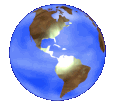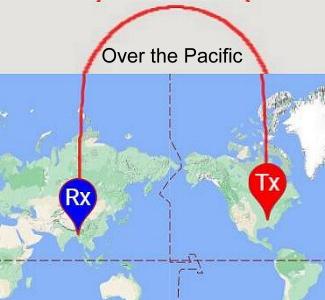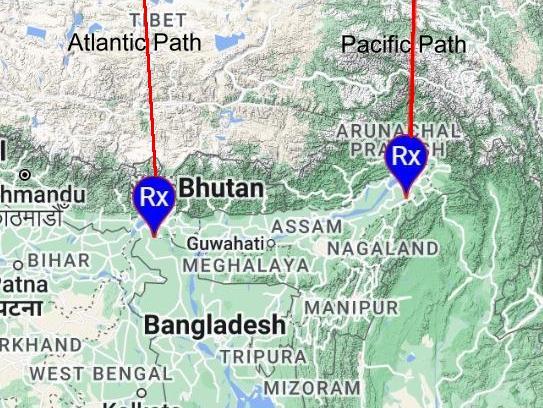Translate this page:
Some Unique Propagation Paths

Some of the guys have commented that I do a lot of Calling CQ DX, and especially to Asia,
and Central Asia. One reason, is I spent several years living in Asia, and enjoy talking
to old friends and making new ones. Another reason, is I enjoy experimenting with Propagation,
and the different times and paths that open during different months.
The hardest place for most hams to contact, is the location that is 1/2 way around the world, called
the antipodes . Any place farther, could be contacted by going the other way around the
world. The Antipodes for me here in western Tennessee, runs through Bangladesh. Signals
from that area can come in over the Pacific or the Atlantic, and depend on time of day,
and which band, can be Short Path over the North Pole, or Long Path over the South Pole.
Every once in a while, something weird will happen, and you will get a Skewed Path over
Africa or some other odd path. I find working these almost as enjoyable as the QSO.
Below shows where my antipodes runs through Bangladesh. These paths are only theoretical,
as can easily follow either path in that area, especially when there can be E Skip involved
on either end of the path skewing the path a few hundred miles either way. As you can see,
you could work someone in Bangladesh Short Path over the Atlantic or Pacific, or Long Path
over the South pole, and up over the south Atlantic or Pacific. Fun Stuff.



My antipodes, half way around the world
There are several tools to use to help perdict when there is propagation to
certain areas. During my many overseas asignnments in the Army,
Another aspect of Ham Radio that I really enjoy, is studying propagation.
Learning about how the the MUF (Maximum Usable Frequency) rises during the
day, and gets much higher during the Solar peak years. Most countries have
some knowledge requirement on this for the operators license. The area that
very few cover, is Long Path Propagation.
I learned a lot about propagation while in the Army. I spent many years
operating in other countries. I spent 4 asignments in Korea, and spent most of
my spare time doing Radio things. One of the things that I found very useful,
was the WWV and WWVH radio transmissions on 5, 10, 15, 20, and 25.000 MHZ. To
check for unique propagation paths, I would put a receiver on the closest
frequency to what I was interested in, adjust the squelch to make only above S4
or so signals to be heard, then do other things in the shack, even sleep. I had
several wire yagi's and a vertical. When I checked, and sometimes heard WWV
better on the vertical, I noted LP in my notes. I latter built a large V beam
for LP.
Using this method, you could check for LP on 15 and 10m. I hear VU often on 10m
between 14-19Z in the Summer and Winter, and also 24 to 03:00Z during the
Winter. 15m comes through 21-01:00 Z LP in Summer, and also 21-0100Z in the
Winter. Your opens should be similar, allowing for difference in Gray Line, SR
and SS.
I have worked S2 on 10m, but it was back in 1993 at 01:30Z Bangladesh is so far
to the east from here, that the signals can easily go over the north pole, and
come down over Alaska, as I suspect it did on this qso. LP can also come up over
the South Atlantic, instead of the South Pacific. These odd paths seem to happen
at very high SFI numbers, over 225.
I thought I would touch on another area of propagation detection I use. You
hear a lot of guys disliking FT8. Several years ago, at the bottom of the
cycle, I decided to try to use FT8, when some of the DX peditions started
using it. At the time I was missing FT8W Crozet Island and BS7 Scarborough
Reef. I decided I wanted to have it working just in case.... Well, since then,
I have learned that FT8 is very good to use as a propagation tool.
The 1st thing I determined for my station was, if the FT8 signals are -10 or
stronger, I could most likely work them on SSB. I also use it to spot long path
and skewed path, by watching the signal strength on certain signals for a few
mins, the turn my antenna and check for other paths. This is not always 100%
accurate due to QSB, but is very useful. I did this a couple of days last month,
and detected some LP coming from South Korea. I used the FT8 chat mode, and SSB
LP, then 28.480. I them QSYed and started Calling CQ DX Long Path several times.
5 mins latter, a HL answered my call. I use FT8 mostly as a propagation
tool now, and still get a smile on my face when I snag some one on long path. I
still need BS7, and if someone ever activates it, I will be in the pile no
matter if SSB, FT8, or CW. ?? I use FT8 now as a Tool for propagation mainly.





